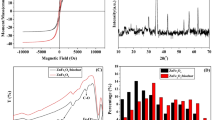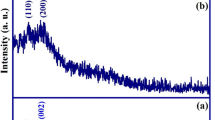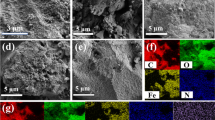Abstract
The use of banana peel as a sustainable and low-cost precursor for the fabrication of effective biochar was exploited. Here, calcined magnetic biochar (CMB) was fabricated and characterized. CMB possesses surface acidic functional groups (–OH and COO−), porous structures, high saturation magnetization (39.55 emu/g), and larger surface area than the non-magnetic biochar (CB). The CMB adsorption performance (72.8, 75.9, and 83.4 mg/g for Zn2+, Cu2+, and Hg2+, respectively at pH 6) in a single component was described suitably by pseudo-second order kinetic model, Langmuir, and Redlich-Peterson adsorption isotherms. Notably, the selectivity factor values in the extended Langmuir isotherm indicated that CMB has higher adsorption affinity toward Hg2+ than Cu2+ and Zn2+ in the multi-component system. Owing to its high adsorption efficiency and fast and easy separation, the calcined magnetic biochar is considered promising and effective for the purification of heavy metal–bearing wastewater.







Similar content being viewed by others
References
Ahmad T, Danish M (2018) Prospects of banana waste utilization in wastewater treatment: a review. J Environ Manag 206:330–348
Ahmad Z, Gao B, Mosa A, Yu H, Yin X, Bashir A, Ghoveisi H, Wang S (2018) Removal of Cu(II), Cd(II) and Pb(II) ions from aqueous solutions by biochars derived from potassium-rich biomass. J Clean Prod 180:437–449
Bouhamed F, Elouear Z, Bouzid J, Ouddane B (2016) Multi-component adsorption of copper, nickel and zinc from aqueous solutions onto activated carbon prepared from date stones. Environ Sci Pollut Res 23:15801–15806
Ali A, Saeed K (2015) Phenol removal from aqueous medium using chemically modified banana peels as low-cost adsorbent. Desal Water Treat 57:11242–11254
Cataldo S, Gianguzza A, Pettignano A, Villaescusa I (2013) Mercury(II) removal from aqueous solution by sorption onto alginate, pectate and polygalacturonate calcium gel beads. A kinetic and speciation based equilibrium study. React Funct Polym 73:207–217
Cutillas-Barreiro L, Paradelo R, Igrexas-Soto A, Núñez-Delgado A, Fernández-Sanjurjo MJ, Álvarez-Rodriguez E, Garrote G, Nóvoa-Muñoz JC, Arias-Estévez M (2016) Valorization of biosorbent obtained from a forestry waste: competitive adsorption, desorption and transport of Cd, Cu, Ni, Pb and Zn. Ecotoxicol Environ Saf 131:118–126
DeMessie B, Sahle-Demessie E, Sorial GA (2015) Cleaning water contaminated with heavy metal ions using pyrolyzed biochar adsorbents. Sep Sci Technol 50:2448–2457
Ding Y, Liu Y, Liu S, Li Z, Tan X, Huang X, Zeng G, Zhou Y, Zheng B, Cai X (2016) Competitive removal of Cd (II) and Pb (II) by biochars produced from water hyacinths: performance and mechanism. RSC Adv 6:5223–5232
Godiya CB, Liang M, Sayed SM, Li D, Lu X (2019) Novel alginate/polyethyleneimine hydrogel adsorbent for cascaded removal and utilization of Cu2+ and Pb2+ ions. J Environ Manag 232:829–841
EPA (1982) Electroplating and metal finishing effluent guidelines & standards. US Environmental Protection Agency. Available from: http://www.epa.gov/electroplating-and-metal-finishing_proposed-rule_08-31-1982_47-fr-38462.pdf. Accessed 1 June 2019
Faheem YH, Liu J, Shen J, Sun X, Li J, Wang L (2016) Preparation of MnOx-loaded biochar for Pb2+ removal: adsorption performance and possible mechanism. J Taiwan Inst Chem Eng 66:313–320
Fu F, Wang Q (2011) Removal of heavy metal ions from wastewaters: a review. J Environ Manag 92:407–418
Gazi M, Oladipo AA, Azalok KA (2018) Highly efficient and magnetically separable palm seed-based biochar for the removal of nickel. Sep Sci Technol 7:1124–1131
Giwa A, Dindi A, Kujawa J (2019) Membrane bioreactors and electrochemical processes for treatment of wastewaters containing heavy metal ions, organics, micropollutants and dyes: recent developments. J Hazard Mater 370:172–195
Hasan SH, Srivastava P (2009) Batch and continuous biosorption of Cu2+ by immobilized biomass of Arthrobacter sp. J Environ Manag 90:3313–3321
Ho YS (2006) Review of second-order models for adsorption systems. J Hazard Mater 136:681–689
Jia Y, Zhang Y, Fu J, Yuan L, Li Z, Liu C, Zhao D, Wang X (2019) A novel magnetic biochar/MgFe-layered double hydroxides composite removing Pb2+ from aqueous solution: isotherms, kinetics and thermodynamics. Colloids Surf A Physicochem Eng Asp 567:278–287
Jiang R, Tian J, Zheng H, Qi J, Sun S, Xi L (2015) A novel magnetic adsorbent based on waste litchi peels for removing Pb(II) from aqueous solution. J Environ Manag 155:24–30
Lasheen MR, El-Sherif IY, Sabry DY, El-Wakeel ST, El-Shahat MF (2015) Adsorption of heavy metals from aqueous solution by magnetite nanoparticles and magnetite-kaolinite nanocomposite: equilibrium, isotherm and kinetic study. Desal Water Treat 57:17421–17429
Li Y, Bai P, Yan Y, Yan W, Shi W, Xu R (2019a) Removal of Zn2+, Pb2+, Cd2+, and Cu2+ from aqueous solution by synthetic clinoptilolite. Microporous Mesoporous Mater 273:203–211
Li M, Liu H, Chen T, Dong C, Sun Y (2019b) Synthesis of magnetic biochar composites for enhanced uranium (VI) adsorption. Sci Total Environ 651:1020–1028
Liu C, Ngo HH, Guo W, Tung KL (2012) Optimal conditions for preparation of banana peels, sugarcane bagasse and watermelon rind in removing copper from water. Bioresour Technol 119:349–354
Milenkovic DD, Milosavljevic MM, Marinkovic AD, Dokic VR, Mitrovic JZ, Bojic AL (2013) Removal of copper (II) ion from aqueous solution by high-porosity activated carbon. Water SA 39:515–522
Mohan D, Kumar H, Sarswat A, Alexandre-Franco M, Pittman CU Jr (2014) Cadmium and lead remediation using magnetic oak wood and oak bark fast pyrolysis bio-chars. Chem Eng J 236:513–528
Mousavi SJ, Parvini M, Ghorbani M (2018) Adsorption of heavy metals (Cu2+ and Zn2+) on novel bifunctional ordered mesoporous silica: optimization by response surface methodology. J Taiwan Inst Chem Eng 84:123–141
Oladipo AA, Gazi M (2015a) Two-stage batch sorber design and optimization of biosorption conditions by Taguchi methodology for the removal of acid red 25 onto magnetic biomass. Korean J Chem Eng 32:1864–1878
Oladipo AA, Gazi M (2015b) Microwaves initiated synthesis of activated carbon-based composite hydrogel for simultaneous removal of copper(II) ions and direct red 80 dye: a multi-component adsorption system. J Taiwan Inst Chem Eng 47:125–136
Oladipo AA, Gazi M, Yilmaz E (2015) Single and binary adsorption of azo and anthraquinone dyes by chitosan-based hydrogel: selectivity factor and Box-Behnken process design. Chem Eng Res Des 104:264–279
Oladipo AA (2018a) Microwave-assisted synthesis of high-performance polymer based nanoadsorbents for pollution control. In: Hussain CM, Mishra AK (eds) New polymer nanocomposites for environmental remediation, vol 1. Elsevier, pp 337–359
Oladipo AA (2018b) Bioinspired nanocomposites for adsorptive and photo-assisted decontamination of wastewater. In: Hussain CM, Mishra AK (eds) Nanotechnology in environmental science, vol 1. Wiley-VCH Publishers, pp 685–706
Oladipo AA (2018c) Biosynthesized and bio-inspired functional nanocomposites for pollution control. In: Hussain CM, Mishra AK (eds) Nanocomposites for pollution control, vol 1. Pan Stanford Publishers, pp 501–525
Oladipo AA, Ifebajo AO (2018) Highly efficient magnetic chicken bone biochar for removal of tetracycline and fluorescent dye from wastewater: two-stage adsorber analysis. J Environ Manag 209:9–16
Oladipo AA, Ifebajo AO, Gazi M (2019) Magnetic LDH-based CoO–NiFe2O4 catalyst with enhanced performance and recyclability for efficient decolorization of Azo dye via Fenton-like reactions. Appl Catal B Environ 243:243–252
Pap S, Bezanovic V, Radonic J, Babic A, Saric S, Adamovic D, Sekulic MT (2018) Synthesis of highly efficient functionalized biochars from fruit industry waste biomass for the removal of chromium and lead. J Mol Liq 268:315–325
Renata SD, Caetano CL, Ferreira G, Padilha PM, Saeki MJ, Zara LF, Martines MAU, Castro GR (2011) Banana peel applied to the solid phase extraction of copper and lead from river water: preconcentration of metal ions with a fruit waste. Ind Eng Chem Res 50:3446–3451
Rong X, Xie M, Kong L, Natarajan V, Ma L, Zhan J (2019) The magnetic biochar derived from banana peels as a persulfate activator for organic contaminants degradation. Chem Eng J 372:294–303
Selvanathan M, Yann KT, Chung CH, Selvarajoo A, Arumugasamy SK, Sethu V (2017) Adsorption of copper(II) ion from aqueous solution using biochar derived from rambutan (Nepheliumlappaceum) peel: feedforward neural network modelling study. Water Air Soil Pollut 228:299
Serafin J, Narkiewicz U, Morawski AW, Wróbel RJ, Michalkiewicz B (2017) Highly microporous activated carbons from biomass for CO2 capture and effective micropores at different conditions. J CO2 Utiliz 18:73–79.
Shah MP, Reddy P, Banerjee GV, Babu PR, Kothari IL (2005) Microbial degradation of banana waste under solid state bioprocessing using two lignocellulolytic fungi (Phylosticta spp. MPS-001 and Aspergillus spp. MPS-002). Process Biochem 40:445–451
Sizmur T, Fresno T, Akgül G, Frost H, Moreno-Jiménez E (2017) Biochar modification to enhance sorption of inorganics from water. Bioresour Technol 246:34–47
Song J, He Q, Hu X, Zhang W, Wang C, Chen R, Wang H, Ahmed M (2019) Highly efficient removal of Cr(VI) and Cu(II) by biochar derived from Artemisia argyi stem. Environ Sci Pollut Res 26:13221–13234
Tan X, Liu Y, Zeng G, Wang X, Hu X, Gu Y, Yang Z (2015) Application of biochar for the removal of pollutants from aqueous solutions. Chemosphere 125:70–85
Tauanov Z, Tsakiridis PE, Mikhalovsky SV, Inglezakis VJ (2018) Synthetic coal fly ash-derived zeolites doped with silver nanoparticles for mercury (II) removal from water. J Environ Manag 224:164–171
Temesgen F, Gabbiye N, Sahu O (2018) Biosorption of reactive red dye (RRD) on activated surface of banana and orange peels: economical alternative for textile effluent. Surf Interface 12:151–159
Tran HN, Lee CK, Vu MT, Chao HP (2017) Removal of copper, lead, methylene green 5, and acid red 1 by saccharide-derived spherical biochar prepared at low calcination temperatures: adsorption kinetics, isotherms, and thermodynamics. Water Air Soil Pollut 228:401
Wang Z, Liu G, Zheng H, Li F, Ngo HH, Guo W, Liu C, Chen L, Xing B (2015) Investigating the mechanisms of biochar’s removal of lead from solution. Bioresour Technol 177:308–317
World Health Organization (2004) Guidelines for Drinking-water Quality, 3rd. World Health Organization
Yan J, Xue Y, Long L, Zeng Y, Hu X (2018) Adsorptive removal of As(V) by crawfish shell biochar: batch and column tests. Environ Sci Pollut Res 25:34674–34683
Yu D, Wang L, Wu M (2018) Simultaneous removal of dye and heavy metal by banana peels derived hierarchically porous carbons. J Taiwan Inst Chem Eng 93:543–553
Zhong L, Zhang Y, Ji Y, Norris P, Pan WP (2016) Synthesis of activated carbon from coal pitch for mercury removal in coal-fired power plants. J Therm Anal Calorim 123:851–860
Zhou N, Chen H, Xi J, Yao D, Zhou Z, Tian Y, Lu X (2017) Biochars with excellent Pb(II) adsorption property produced from fresh and dehydrated banana peels via hydrothermal carbonization. Bioresour Technol 232:204–210
Author information
Authors and Affiliations
Corresponding author
Additional information
Responsible editor: Tito Roberto Cadaval Jr
Publisher’s note
Springer Nature remains neutral with regard to jurisdictional claims in published maps and institutional affiliations.
Electronic supplementary material
ESM 1
(DOCX 55 kb)
Rights and permissions
About this article
Cite this article
Oladipo, A.A., Ahaka, E.O. & Gazi, M. High adsorptive potential of calcined magnetic biochar derived from banana peels for Cu2+, Hg2+, and Zn2+ ions removal in single and ternary systems. Environ Sci Pollut Res 26, 31887–31899 (2019). https://doi.org/10.1007/s11356-019-06321-5
Received:
Accepted:
Published:
Issue Date:
DOI: https://doi.org/10.1007/s11356-019-06321-5




